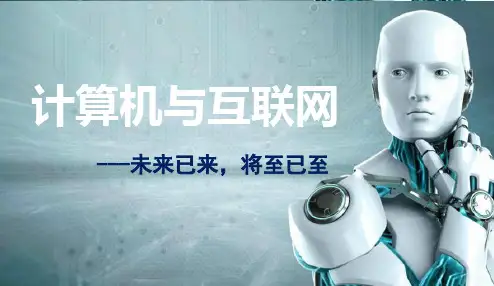计算机网络英文教材ppt第四篇
- 格式:ppt
- 大小:3.33 MB
- 文档页数:96
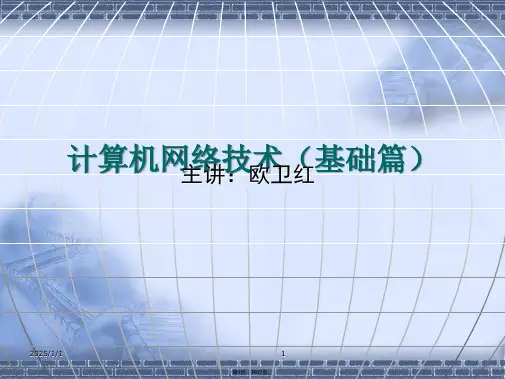
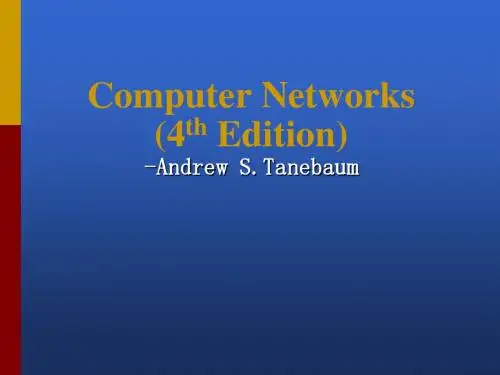

01计算机网络概述Chapter定义发展历程组成分类功能应用02物理层与数据链路层Chapter物理层的基本概念与传输介质物理层定义传输介质物理层接口物理层设备01020304数据链路层定义帧同步数据链路层功能差错控制数据链路层的基本概念与功能差错控制与流量控制差错控制方法流量控制机制停止-等待协议滑动窗口协议03网络层与传输层Chapter网络层定义主要功能关键协议030201网络层的基本概念与功能路由选择与拥塞控制路由选择01拥塞控制02关键技术03传输层定义计算机网络中负责实现端到端数据传输的层次,提供可靠或不可靠的数据传输服务。
要点一要点二主要功能包括建立、维护和终止端到端的连接,数据分段与重组,流量控制与差错控制等,确保数据的可靠传输。
关键协议TCP 协议(Transmission Control Protocol )和UDP 协议(User Datagram Protocol )是传输层的两个主要协议,分别提供可靠和不可靠的数据传输服务。
TCP 协议具有流量控制、差错控制等机制,适用于对数据传输可靠性要求较高的场景;而UDP 协议则具有较快的传输速度,适用于对实时性要求较高的场景。
要点三传输层的基本概念与功能04应用层与网络安全Chapter应用层的基本概念应用层是计算机网络体系结构中的最高层,负责为用户提供各种网络服务和应用程序接口。
它直接与用户和应用程序交互,处理网络应用中的各种问题。
应用层的主要功能包括以下几个方面。
应用层通过图形用户界面(GUI)或命令行界面(CLI)等方式,为用户提供与网络服务交互的接口。
应用层支持各种网络服务,如电子邮件、文件传输、远程登录等,以满足用户的需求。
应用层负责将数据转换为网络可传输的格式,如将文本转换为ASCII码,将图像转换为JPEG或PNG格式等。
应用层的功能支持网络服务数据格式转换提供用户界面应用层的基本概念与功能网络安全的防范策略为了保障网络安全,需要采取一系列的防范策略,包括以下几个方面。
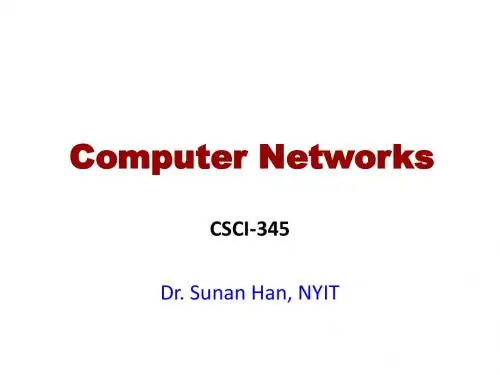
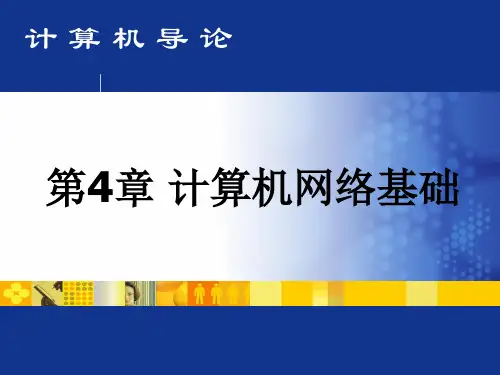
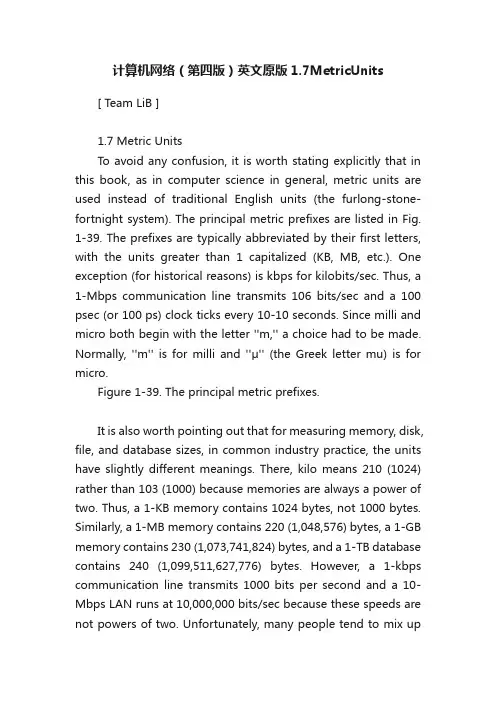
计算机网络(第四版)英文原版1.7MetricUnits [ Team LiB ]1.7 Metric UnitsTo avoid any confusion, it is worth stating explicitly that in this book, as in computer science in general, metric units are used instead of traditional English units (the furlong-stone-fortnight system). The principal metric prefixes are listed in Fig. 1-39. The prefixes are typically abbreviated by their first letters, with the units greater than 1 capitalized (KB, MB, etc.). One exception (for historical reasons) is kbps for kilobits/sec. Thus, a 1-Mbps communication line transmits 106 bits/sec and a 100 psec (or 100 ps) clock ticks every 10-10 seconds. Since milli and micro both begin with the letter ''m,'' a choice had to be made. Normally, ''m'' is for milli and ''μ'' (the Greek letter mu) is for micro.Figure 1-39. The principal metric prefixes.It is also worth pointing out that for measuring memory, disk, file, and database sizes, in common industry practice, the units have slightly different meanings. There, kilo means 210 (1024) rather than 103 (1000) because memories are always a power of two. Thus, a 1-KB memory contains 1024 bytes, not 1000 bytes. Similarly, a 1-MB memory contains 220 (1,048,576) bytes, a 1-GB memory contains 230 (1,073,741,824) bytes, and a 1-TB database contains 240 (1,099,511,627,776) bytes. However, a 1-kbps communication line transmits 1000 bits per second and a 10-Mbps LAN runs at 10,000,000 bits/sec because these speeds are not powers of two. Unfortunately, many people tend to mix upthese two systems, especially for disk sizes. To avoid ambiguity, in this book, we will use the symbols KB, MB, and GB for 210, 220, and 230 bytes, respectively, and the symbols kbps, Mbps, and Gbps for 103, 106, and 109 bits/sec, respectively.[ Team LiB ]。
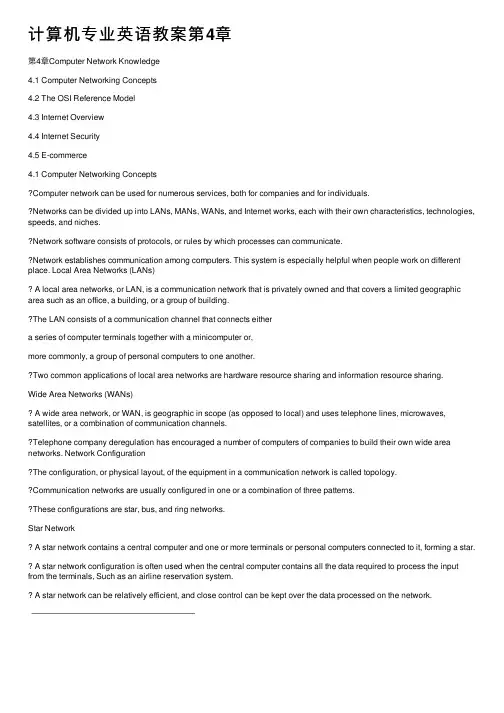
计算机专业英语教案第4章第4章Computer Network Knowledge4.1 Computer Networking Concepts4.2 The OSI Reference Model4.3 Internet Overview4.4 Internet Security4.5 E-commerce4.1 Computer Networking ConceptsComputer network can be used for numerous services, both for companies and for individuals.Networks can be divided up into LANs, MANs, WANs, and Internet works, each with their own characteristics, technologies, speeds, and niches.Network software consists of protocols, or rules by which processes can communicate.Network establishes communication among computers. This system is especially helpful when people work on different place. Local Area Networks (LANs)A local area networks, or LAN, is a communication network that is privately owned and that covers a limited geographic area such as an office, a building, or a group of building.The LAN consists of a communication channel that connects eithera series of computer terminals together with a minicomputer or,more commonly, a group of personal computers to one another.Two common applications of local area networks are hardware resource sharing and information resource sharing.Wide Area Networks (WANs)A wide area network, or WAN, is geographic in scope (as opposed to local) and uses telephone lines, microwaves, satellites, or a combination of communication channels.Telephone company deregulation has encouraged a number of computers of companies to build their own wide area networks. Network ConfigurationThe configuration, or physical layout, of the equipment in a communication network is called topology.Communication networks are usually configured in one or a combination of three patterns.These configurations are star, bus, and ring networks.Star NetworkA star network contains a central computer and one or more terminals or personal computers connected to it, forming a star.A star network configuration is often used when the central computer contains all the data required to process the input from the terminals, Such as an airline reservation system.A star network can be relatively efficient, and close control can be kept over the data processed on the network.Bus NetworkWhen a bus network is used, all the devices in the network are connected to a single cable.Information is transmitted in either direction from any one personal computer to another.An advantage of the bus network is that devices can be attached or detached from the network at any point without disturbing the rest of the network.Ring NetworkA ring network does not use a centralized host computer. Rather, a circle of computers communicate with one another.A ring network can be useful when the processing is not done at a central site, but at local sites.An advantage of a ring network is that less cable is usually needed and therefore network cabling costs are lower.Connecting NetworksSometimes you might want to connect separate network. Y ou do this by using gateways and bridges.A gateway is a combination of hardware and software that allows users on one network to access the resources on a different type of network.A bridge is a combination of hardware and software that is used to connect similar networks.4.3 Internet OverviewWeb ServiceThe short-form of a Web Services definition is: “A set of standard s that allow applications to talk to each other over the net.”The “Services” part of Web Services is indicative of the service-oriented nature of application communications.A service can combine multiple back-end application functions into what is known as a “composite application interface”. Web Service interfaces are defined using XML in the form of a “schema” that describes the request and response data formats, types, and relationships.Web Services technology supports increased operational efficiencies and improved service by allowing multiple applications to interoperate.Now that we know a little more about Web Services, lets look at the two different scenarios mentioned above: intra-enterprise, where internal applications are involved; and inter-enterprise, where applications of different trading partners are involved.How To Use InternetMost people connect to the Internet by using network connection or Internet service provider (ISP).An ISP supplies a service number that you can dial from your computer to log on the Internet server.With the communication tools included in Windows 2000, you can use your computer to send e-mail, handle phone calls, send a fax, or conduct a meeting with a video conference.With Internet Explorer and an Internet connection, you can search for and view information on the World Wide Web.Y ou can use Phone Dialer to place telephone calls or participate in video conference calls from your computer.The Windows 2000 Telephony API (TAPI) allows you to configure dialing rules for all telephony applications.4.5 E-commerceE-commerce is doing business through electronic media.It means using simple, fast and low-cost electronic communications to transact, without face-to-face meeting between the two parties of the transaction.Electronic commerce is featured by these characters: fairness and freedom, high efficiency, globalization, virtualization, interactivity, autonomy, personalized service.Electronic commerce will change the environment in which enterprises compete with each other and reduce costs which would otherwise be high in traditional market structure.To ensure security of electronic commerce, an electronic certification center should be established.The features of Electronic CommerceSpace-time concept will change.The nature of market and the behavior of consumers change.Corporate credit and brand become treasured resources.Structure of enterprises will change from “pyramid” type to “flattened” type.Business mode in enterprises will change.Higher require ment of workers’ quality and technique.Material flow will be more important in electronic commerce than in usual commerce.New recognition of information resource and attention resource.E-Commerce StrategiesThe Web is adding new dimensions to conventional business practice and creating new types of business strategies. As computer network facilitates information exchange in a speedy and inexpensive way, Internet now penetrates into almost every corner of the world.Small and medium sized enterprises (SMEs) can forge global relationships with their trading partners everywhere in the world.Businesses can sell goods to customers outside traditional markets, explore new markets and realize business opportunities more easily.Companies must take advantage of customer information in their commerce models.。
